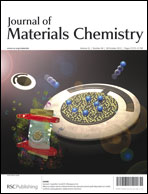Comparison of thiophene- and selenophene-bridged donor–acceptor low band-gap copolymers used in bulk-heterojunction organic photovoltaics†
Abstract
We report a detailed comparison of absorption spectroscopy, electrochemistry, DFT calculations, field-effect charge mobility, as well as organic photovoltaic characteristics between thiophene- and selenophene-bridged donor–acceptor low-band-gap copolymers. In these copolymers, a significant reduction of the band-gap energy was observed for selenophene-bridged copolymers by UV-visible absorption spectroscopy and cyclic voltammetry. Field-effect charge mobility studies reveal that the enhanced hole mobility of the selenophene-bridged copolymers hinges on the solubilising alkyl side chain of the copolymers. Both cyclic voltammetry experiments and theoretical calculations showed that the decreased band-gap energy is mainly due to the lowering of the LUMO energy level, and the raising of the HOMO energy level is just a secondary cause. These results are reflected in a significant increase of the short circuit current density (JSC) but a slight decrease of the open circuit voltage (VOC) of their bulk-heterojunction organic photovoltaics (BHJ OPVs), of which the electron donor materials are a selenophene-bridged donor–acceptor copolymer: poly{9-dodecyl-9H-carbazole-alt-5,6-bis(dodecyloxy)-4,7-di(selenophen-2-yl) benzo[c][1,2,5]-thiadiazole} (pCzSe) or poly{4,8-bis(2-ethylhexyloxy)benzo[1,2-b;4,5-b′]dithiophene-alt-5,6-bis(dodecyloxy)-4,7-di(selenophen-2-yl)benzo[c][1,2,5]-thiadiazole} (pBDTSe), or a thiophene-bridged donor–acceptor copolymer: poly{9-dodecyl-9H-carbazole-alt-5,6-bis(dodecyloxy)-4,7-di(thiophen-2-yl)benzo[c][1,2,5]-thiadiazole} (pCzS) or poly{4,8-bis(2-ethylhexyloxy)benzo[1,2-b;4,5-b′]dithiophene-alt-5,6-bis(dodecyloxy)-4,7-di(thiophen-2-yl)benzo[c][1,2,5]-thiadiazole} (pBDTS); the electron acceptor material is [6,6]-phenyl-C61-butyric acid methyl ester (PCBM). Judging from our device data, the potential Se–Se interactions of the selenophene-bridged donor–acceptor copolymers, which is presumably beneficial for the fill factor (FF) of BHJ OPVs, is rather susceptible to the device fabrication conditions.


 Please wait while we load your content...
Please wait while we load your content...